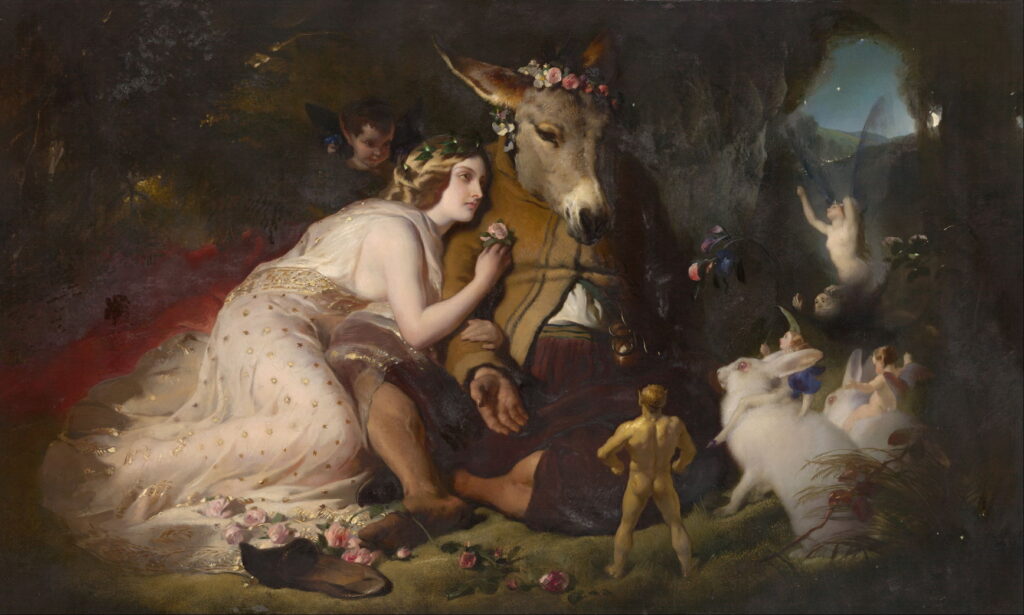Reading visual art: 98 Fairies B

By the middle of the nineteenth century faery painting, inspired mainly by Shakespeare’s play A Midsummer Night’s Dream, had become established as a flourishing sub-genre, and had even spread over the Channel to continental Europe.
Gustave Doré (1832-1883), A Midsummer Night’s Dream (c 1870), further details not known. Image by Foter, via Wikimedia Commons.
Gustave Doré’s A Midsummer Night’s Dream from about 1870 is a grander gathering of both miniature and full-size fairies, with a full moon shining through the trees of the wood.
John Simmons (1823–1876), Titania Sleeping in the Moonlight Protected by her Fairies (date not known), watercolour and gouache, 50.5 x 59 cm, location not known. Wikimedia Commons.
John Simmons’ undated watercolour of Titania Sleeping in the Moonlight Protected by her Fairies is another variation, and one of a series of paintings he made of this play.
John Simmons (1823–1876), Hermia and Lysander (1870), watercolour heightened with gouache on paper laid down on canvas, 89 x 74 cm, Private collection. Wikimedia Commons.
Simmons’ watercolour of Hermia and Lysander from 1870 shows the couple in a thoroughly enchanted wood, with an owl, a peacock feather, foxgloves, cobwebs, and sundry tiny fairies.
Henry Fuseli (1741–1825), Titania, Bottom and the Fairies (1793-94), oil on canvas, 169 x 135 cm, Kunsthaus Zürich, Zürich, Switzerland. Wikimedia Commons.
Henry Fuseli’s painting of Titania, Bottom and the Fairies from 1793-94 shows the queen with her arms around the unfortunate Bottom, while attendant fairies serenade the couple.
George Cruikshank (1792-1878), A Midsummer Night’s Dream, Bottom the Weaver and Titania (c 1845), oil on fiberboard, dimensions not known, Princeton University Art Museum, Princeton, NJ. Image by Daderot, via Wikimedia Commons.
Painted by George Cruikshank in about 1845, shortly after the restoration of Shakespeare’s original play, A Midsummer Night’s Dream, Bottom the Weaver and Titania is an unusual tondo showing a very large Bottom relative to its tiny Titania, under a crescent rather than full moon.
Edwin Landseer (1802–1873), Scene from A Midsummer Night’s Dream. Titania and Bottom (1848-51), oil on canvas, 82 x 133 cm, National Gallery of Victoria, Melbourne, Australia. Wikimedia Commons.
In the middle of the nineteenth century, between 1848-51, the leading railway engineer in Britain, Isambard Kingdom Brunel, who built the Great Western Railway, commissioned one of Queen Victoria’s favourite painters Edwin Landseer to paint Scene from A Midsummer Night’s Dream. Titania and Bottom. This was hung in Brunel’s dining room alongside other paintings of Shakespearean themes.
Henry Fuseli (1741–1825), Titania and Bottom (c 1790), oil on canvas, 217.2 x 275.6 cm, The Tate Gallery (Presented by Miss Julia Carrick Moore in accordance with the wishes of her sister 1887), London. © The Tate Gallery and Photographic Rights © Tate (2016), CC-BY-NC-ND 3.0 (Unported), http://www.tate.org.uk/art/artworks/fuseli-titania-and-bottom-n01228
Henry Fuseli’s liberal fantasy of Titania and Bottom from about 1790 is loosely based on the opening of Act 4 Scene 1 of the play with Titania’s words:
Come, sit thee down upon this flowery bed,
While I thy amiable cheeks do coy,
And stick musk-roses in thy sleek smooth head,
And kiss thy fair large ears, my gentle joy.
Titania (left of centre) calls on her fairies to attend to Bottom, who wears the ass’s head to the right of her. Peaseblossom scratches Bottom’s head, with Mustardseed on his hand, and Cobweb kills a bee to bring its honey to him. Fuseli has borrowed liberally from other sources: Titania’s pose is from Leonardo da Vinci’s Leda (c 1506), the elves at the right from a Botticelli illustration for Dante’s Paradiso (c 1469), and the girl with butterfly wings on her head in the left foreground is based on some of Sir Joshua Reynolds’ child portraits.
A Midsummer Night’s Dream isn’t the only play written by Shakespeare that invokes fairies.
Richard Dadd (1817–1886), Come unto These Yellow Sands (1842), oil on canvas, 55.3 × 77.5 cm, Private collection. Wikimedia Commons.
Richard Dadd’s Come unto These Yellow Sands (1842) refers not to A Midsummer Night’s Dream but The Tempest, and was exhibited with the lines:
Come unto these yellow sands,
And then take hands,
Curt’sied when you have, and kissed
(The wild waves whist).
Foot it featly here and there,
And sweet sprites the burden bear.
However, when it was shown in Liverpool in 1843, Dadd seems to have referred back to Titania in A Midsummer Night’s Dream, who could be the prominent figure on the top of the rock arch.
Faerie paintings were often accepted for exhibition by the Royal Academy and other prestigious organisations.
Sophie Gengembre Anderson (1823–1903), Take the Fair Face of Woman, and Gently Suspending, With Butterflies, Flowers, and Jewels Attending, Thus Your Fairy is Made of Most Beautiful Things (1880), oil on canvas, dimensions not known, Private collection. Wikimedia Commons.
Sophie Anderson entered the faerie painting sub-genre with Take the Fair Face of Woman, and Gently Suspending, With Butterflies, Flowers, and Jewels Attending, Thus Your Fairy is Made of Most Beautiful Things (1880). The title is taken from some verse allegedly by Charles Ede, but the only literary person of that name who I can identify was born long after this work was painted.
By the end of the nineteenth century, faerie paintings had been forgotten, gone in the twinkling of an eye.




